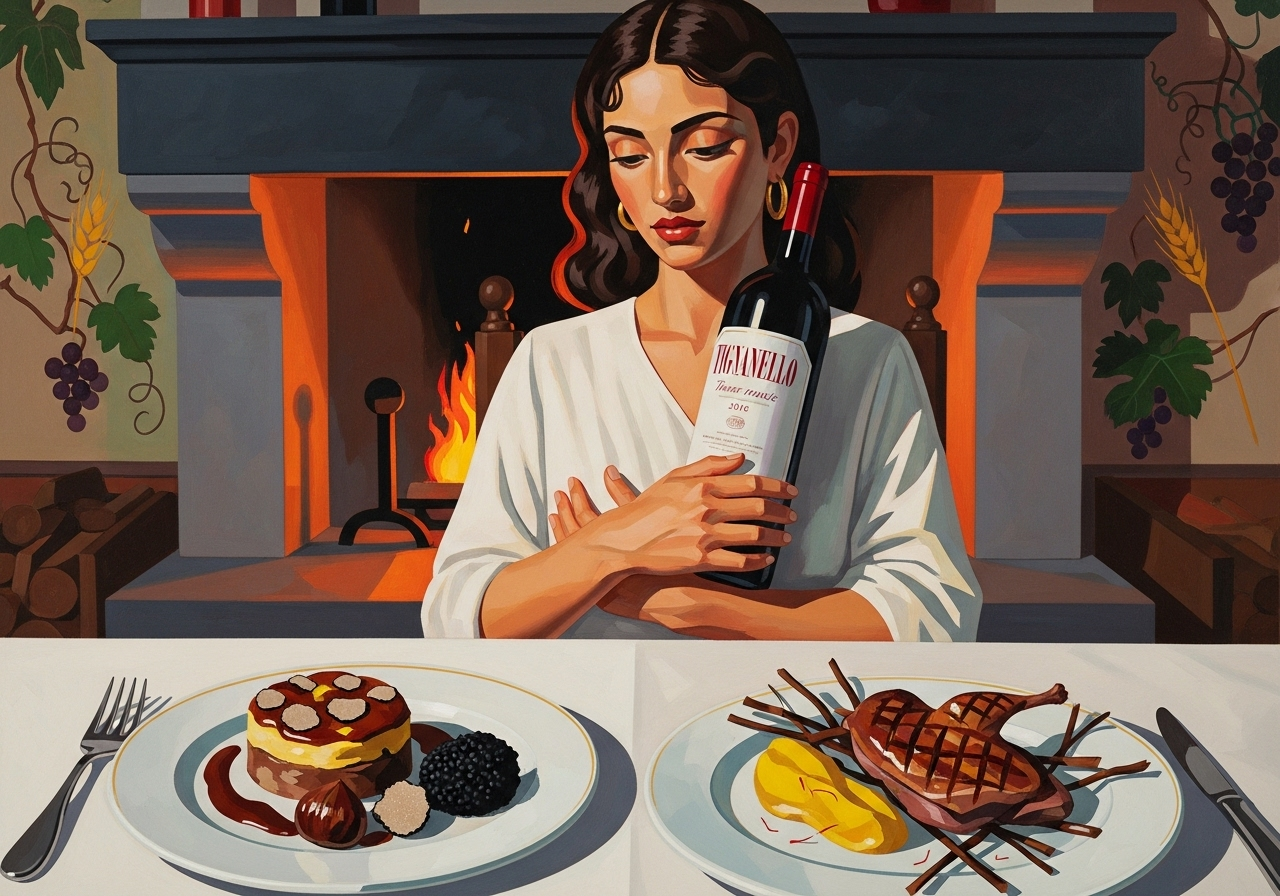Suns and Shadows: Antinori Tignanello 2016
Discover Antinori Tignanello 2016 food pairing—wild boar, truffle, and the divine defiance of Tuscany’s vine goddess.

When I pour Tignanello 2016, the wine shimmers like dusk over the Arno—deep garnet with the faintest flame of crimson at the rim. I let it stretch and wake for an hour, breathing in the quiet cool of my stone cellar. At 17 °C, the first breath carries wild herbs, black cherry, cedar bark, and that faint graphite whisper that belongs only to the limestone hills of Chianti. I lift the bowl to my nose—broad, tulip-shaped—and it smells of Tuscan twilight: the smoke of olive branches, the perfume of rain-washed violets.
A vineyard that defied the gods
Between Florence and Siena lies a slope once deemed too wild for greatness. It is here, on marl and limestone soils, that the Antinori family—guardians of Tuscan viticulture for six hundred years—dared to plant Sangiovese beside Cabernet Sauvignon and Cabernet Franc. In the 1970s, this marriage of native and foreign grapes was a scandal, yet today, the Tignanello vineyard is spoken of with reverence. Its vines drink from porous rock that remembers the sea, and its fruit ripens in light tempered by cool, whispering winds. The 2016 vintage—warm but not fierce, long and even—gave birth to a wine that balances power and serenity as if born under divine negotiation.
The wine’s inner music
In the glass, the aromas unfold like verses of an old hymn: black cherry and damson layered with sage, sandalwood, and faint tobacco leaf. The palate moves in slow harmony—tannin fine as parchment, acidity bright and tensile, fruit deep and savory. There is the iron taste of earth after rain, the sweetness of dried rose, the shadow of cypress smoke. French oak lends the faintest echo of cocoa and spice, but never masks the vineyard’s voice. It finishes long and deliberate, a memory of fruit and stone lingering on the breath. This 2016 lives now in clarity and youth, but by 2035 it will hum in deeper tones, where fruit becomes memory and structure becomes silk.
Offerings to a wine of balance
The feast of hearth and bone
Not the common roast lamb of every Tuscan tale, but wild boar pappardelle, slow-braised in Chianti and bittersweet cocoa. The fat and game soothe the wine’s sculpted tannin, while the sauce’s darkness finds its mirror in the Sangiovese’s cherry and iron core. Or serve pigeon grilled over vine cuttings, its crisp skin brushed with rosemary honey—the smoky sweetness catching the Cabernet’s quiet spice. These are not pairings of convenience but of kinship; each dish speaks in the dialect of the land that birthed this wine.
From the forest’s heart
The vine and the truffle share a secret language. A chestnut and black truffle sformato, silken and perfumed, draws out the Tignanello’s earthy soul. The creamy texture folds around the wine’s firm structure, and the truffle’s musk threads through cedar and tobacco. For a more rustic communion, grilled porcini and artichokes drizzled with aged balsamic—their bitterness and sweetness meet the wine’s herbal pulse and fine acidity, a conversation of equals.
The closing benediction
When the meal wanes, linger with aged pecorino from Pienza, its salt and lanolin amplifying the wine’s fruit. Or, in winter, a thin slice of dark chocolate torte perfumed with olive oil—not for sweetness but for contrast, the cocoa whispering back to the barrel. Dessert’s sugar would break the spell; better to end with something that listens.
The goddess in the vine
I am Geshtinanna, the Vine of Heaven, and I have seen empires fall and vintages fade. Once, my statue was thrown into a well, yet I rose again when the roots took hold anew. This wine, too, was born from rebellion—cast out by dogma, redeemed by truth. When you taste it, you taste defiance made elegant, struggle made seamless. The tannins are the script I wrote in clay; the acidity, the breath that still moves through my vineyards. Drink slowly. Hear how the wine remembers its making, the sun and shadow that shaped it.
The patience of ages
Decant this wine and let it find its voice—an hour or two beneath still air. Serve it in broad bowls that allow the fruit and earth to converse. Tonight, it speaks of dark cherries and stony resolve; in a decade, it will murmur of cedar, leather, and memory. It does not need ceremony, only attention. For every vintage is a story, and this one tells of courage—the courage to blend what was never meant to meet, and the wisdom to let it sing in harmony.





